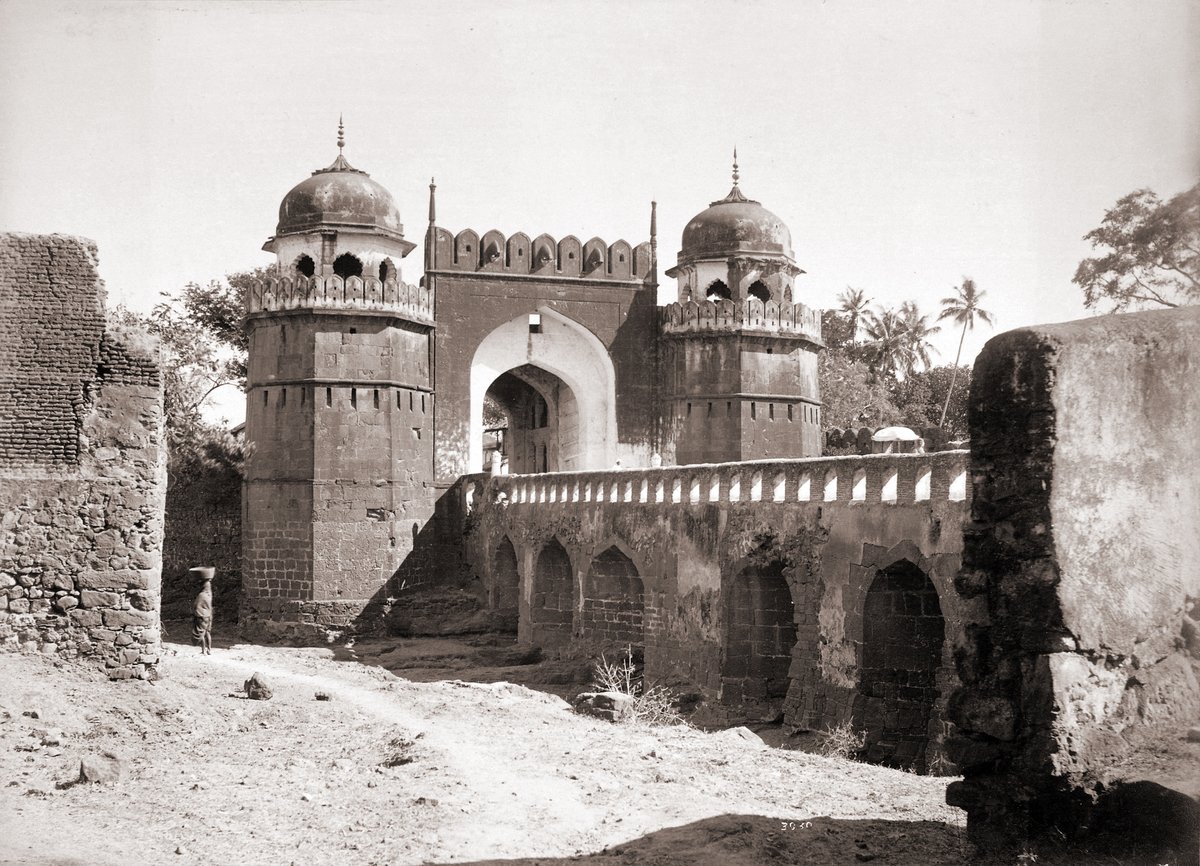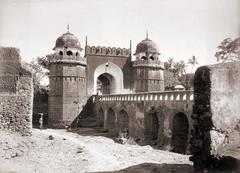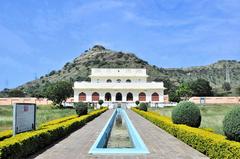
Makai Gate Aurangabad: Complete Visitor Guide, History, and Travel Tips
Date: 14/06/2025
Introduction
Makai Gate, also known as Mecca Gate, is one of the most distinguished gateways in Aurangabad, Maharashtra—a city famed for its historic fortifications and rich Mughal heritage. As one of the few surviving entrances of the original 52 that gave Aurangabad its nickname, “City of Gates,” Makai Gate stands as a testament to the city’s architectural grandeur, strategic significance, and dynamic urban life. This comprehensive guide covers everything you need to know for your visit, from historical context and architectural features to practical travel tips and conservation efforts. Whether you’re a history enthusiast, photographer, or traveler exploring Maharashtra’s gems, Makai Gate offers an experience that bridges the city’s illustrious past with its vibrant present.
Table of Contents
- Introduction
- History and Origins
- Architectural Features and Artistic Significance
- Strategic and Cultural Importance
- Visiting Information: Hours, Tickets, and Accessibility
- How to Get There
- On-Site Experience and Nearby Attractions
- Preservation and Conservation Efforts
- Practical Travel Tips
- Frequently Asked Questions (FAQ)
- Conclusion
- References
History and Origins
Constructed in the late 17th century during the reign of Mughal Emperor Aurangzeb, Makai Gate served as a critical northern entry point to the fortified city of Aurangabad. The gate’s name, “Makai,” is derived from “Mecca,” reflecting Islamic influences and the tradition of naming important structures after sacred sites. Aurangabad, originally founded by Malik Ambar in 1610, was later fortified with walls and gates under Aurangzeb’s rule to defend against invasions and control trade routes. Makai Gate, in particular, was a strategic checkpoint on the road from Jalna, marking the transition from countryside to city and regulating movement of goods and people (Tripcrafters; Evendo).
Architectural Features and Artistic Significance
Makai Gate is a striking example of the fusion between Mughal and Deccan architectural traditions. Its most notable features include:
- Twin Towers and Domed Pavilions: Two imposing towers capped with domes, featuring small chhatris (pavilions) and galleries for guards and ceremonial use.
- Grand Arched Entrances: The central arch is flanked by smaller arches, showcasing symmetry and Mughal design aesthetics.
- Ornamental Detailing: Intricate stone carvings, floral and geometric motifs, and faded calligraphy demonstrate the craftsmanship of the era (Google Arts & Culture).
- Defensive Design: Heavy iron-spiked wooden doors, narrow surveillance windows, and thick walls ensured the gate’s utility in city defense.
- Integration with Urban Landscape: The adjacent bridge over the Kham River and surrounding Mughal gardens highlight the importance of urban planning (Evendo).
Strategic and Cultural Importance
Mughal-Era Defense
Strategically located, Makai Gate was essential for monitoring and defending the northern approaches to Aurangabad, especially as the city became Aurangzeb’s Deccan capital. Its design reflects both military utility and ceremonial grandeur, acting as a barrier and a welcoming portal for visiting dignitaries (Tripcrafters).
Symbolic and Community Role
Beyond its military function, Makai Gate has long served as a symbol of Aurangabad’s cosmopolitan spirit and Islamic heritage. It remains a cultural icon, hosting local processions and celebrations, and continues to anchor community life and urban identity (arorataxi.com; Evendo).
Visiting Information: Hours, Tickets, and Accessibility
- Visiting Hours: Open daily from 8:00 AM to 6:00 PM (Aurangabad Tourism). Some sources note the site is accessible 24 hours, but it is best to visit during daylight for safety and optimal viewing (Yappe.in).
- Entry Fee: Free for all visitors.
- Accessibility: The approach features narrow lanes, best navigated on foot or two-wheeler. The main area is pedestrian-friendly, though uneven surfaces may pose challenges for visitors with mobility issues.
- Guided Tours: Local guides are available and recommended for historical context; heritage walks often include Makai Gate alongside other major sites (aurangabadtourism.in).
How to Get There
- By Foot: About 2 km from Aurangabad Railway Station and 1 km from Osmanpura city center. Walking is feasible for those staying nearby (Evendo).
- By Auto Rickshaw: Widely available, costing ₹30–50 from the city center.
- By Local Bus: Buses towards Bibi Ka Maqbara stop nearby; expect a short walk from the nearest stop.
- By Bicycle: Rentals are available; the ride from the city center takes 20–25 minutes.
On-Site Experience and Nearby Attractions
Atmosphere
Makai Gate is surrounded by bustling markets, street vendors, and tea stalls—offering an authentic slice of local life (Evendo). The juxtaposition of historic architecture with vibrant urban activity creates a unique experience for visitors.
Notable Features
- Cannon Installation: A unique feature among Aurangabad’s gates, visible atop Makai Gate (Wikipedia).
- Chattris and Ornamentation: Domed pavilions and white-painted battlements enhance the gate’s visual appeal.
- Photography: Early mornings and late afternoons offer the best light for capturing the gate’s details and lively surroundings.
Nearby Attractions
- Bibi Ka Maqbara: The “Taj of the Deccan,” a short walk from Makai Gate.
- Aurangabad Caves, Daulatabad Fort, Grishneshwar Temple: Other significant Mughal and medieval sites within easy reach.
- Local Markets: Ideal for purchasing handicrafts and souvenirs like Paithani sarees and Himroo shawls (arorataxi.com).
Preservation and Conservation Efforts
Makai Gate has endured centuries but faces modern challenges such as environmental wear, urban encroachment, and structural risks (ThePrint; Lokmat). Recent conservation initiatives by the Maharashtra State Archaeology Department focus on:
- Removing Encroachments: Ongoing clearance to restore the historical context.
- Structural Repairs: Addressing moisture, foundation stability, and removing modern infrastructure that threatens the gate.
- Heritage Awareness: Community events, clean-up drives, and educational programs to foster public stewardship (Lokmat).
- Archaeological Discoveries: Recent excavations have uncovered ancient water management systems near the gate (ThePrint).
Practical Travel Tips
- Best Visit Time: October to March for pleasant weather; avoid peak summer and monsoon.
- Dress & Etiquette: Dress modestly, especially during religious events or festivals.
- Amenities: Restrooms are limited; facilities are better at larger nearby attractions or hotels.
- Safety: The area is generally safe, but exercise caution with valuables in crowds.
- Language: Marathi, Hindi, and Urdu are common; English is used at tourist sites.
- Connectivity: Strong mobile coverage and clear signage.
Frequently Asked Questions (FAQ)
Q: Is there an entry fee for Makai Gate?
A: No, entry is free for all visitors.
Q: What are the opening hours?
A: Generally open from 8:00 AM to 6:00 PM, but some sources indicate 24-hour accessibility.
Q: Can I join a guided tour?
A: Yes, local guides and heritage walks often include Makai Gate.
Q: Is Makai Gate wheelchair accessible?
A: The approach is pedestrian-friendly, but some uneven surfaces may require assistance.
Q: What is the best time for photography?
A: Early morning or late afternoon for optimal natural light.
Q: Are there amenities nearby?
A: Food stalls and small shops are abundant, but restroom and parking facilities are limited.
Conclusion
Makai Gate is more than a historical monument—it is a living emblem of Aurangabad’s Mughal legacy, urban vibrancy, and cultural resilience. Its free, daily accessibility and proximity to major attractions like Bibi Ka Maqbara make it an ideal destination for both casual visitors and heritage seekers. Ongoing preservation efforts underscore the importance of community engagement in safeguarding this architectural gem for future generations. Plan your visit to Makai Gate to step through a gateway into Aurangabad’s layered history and enduring cultural spirit.
For more detailed travel guides, real-time updates, and curated itineraries, download the Audiala app and follow our social channels.
References
- Tripcrafters
- Evendo
- ThePrint
- Lokmat
- arorataxi.com
- aurangabadtourism.in
- Yappe.in
- Wikipedia
- HelloTravel
- TourMyIndia
- India Imagine
- Google Arts & Culture

